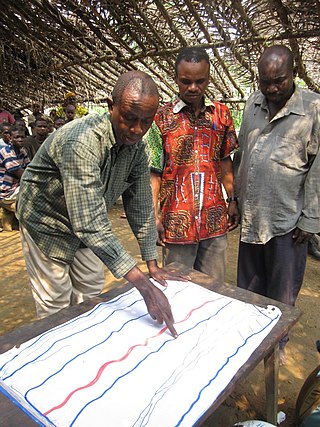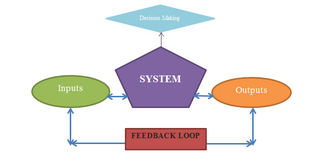Related Research Articles

In computing, a data warehouse, also known as an enterprise data warehouse (EDW), is a system used for reporting and data analysis and is a core component of business intelligence. Data warehouses are central repositories of data integrated from disparate sources. They store current and historical data organized so as to make it easy to create reports, query and get insights from the data. Unlike databases, they are intended to be used by analysts and managers to help make organizational decisions.

A design is the concept of or proposal for an object, process, or system. The word design refers to something that is or has been intentionally created by a thinking agent, and is sometimes used to refer to the inherent nature of something – its design. The verb to design expresses the process of developing a design. In some cases, the direct construction of an object without an explicit prior plan may also be considered to be a design. A design is expected to have a purpose within a certain context, usually having to satisfy certain goals and constraints and to take into account aesthetic, functional, economic, environmental, or socio-political considerations. Traditional examples of designs include architectural and engineering drawings, circuit diagrams, sewing patterns, and less tangible artefacts such as business process models.

The École Polytechnique Fédérale de Lausanne (EPFL) is a public research university in Lausanne, Switzerland. Founded in 1969 with the mission to "train talented engineers in Switzerland", it is inspired by the École Centrale Paris.

Computer-aided software engineering (CASE) is a domain of software tools used to design and implement applications. CASE tools are similar to and are partly inspired by computer-aided design (CAD) tools used for designing hardware products. CASE tools are intended to help develop high-quality, defect-free, and maintainable software. CASE software was often associated with methods for the development of information systems together with automated tools that could be used in the software development process.
System of systems is a collection of task-oriented or dedicated systems that pool their resources and capabilities together to create a new, more complex system which offers more functionality and performance than simply the sum of the constituent systems. Currently, systems of systems is a critical research discipline for which frames of reference, thought processes, quantitative analysis, tools, and design methods are incomplete.referred to system of systems engineering.
Participatory design is an approach to design attempting to actively involve all stakeholders in the design process to help ensure the result meets their needs and is usable. Participatory design is an approach which is focused on processes and procedures of design and is not a design style. The term is used in a variety of fields e.g. software design, urban design, architecture, landscape architecture, product design, sustainability, graphic design, industrial design, planning, and health services development as a way of creating environments that are more responsive and appropriate to their inhabitants' and users' cultural, emotional, spiritual and practical needs. It is also one approach to placemaking.

Computer-integrated manufacturing (CIM) is the manufacturing approach of using computers to control the entire production process. This integration allows individual processes to exchange information with each part. Manufacturing can be faster and less error-prone by the integration of computers. Typically CIM relies on closed-loop control processes based on real-time input from sensors. It is also known as flexible design and manufacturing.
Design methods are procedures, techniques, aids, or tools for designing. They offer a number of different kinds of activities that a designer might use within an overall design process. Conventional procedures of design, such as drawing, can be regarded as design methods, but since the 1950s new procedures have been developed that are more usually grouped under the name of "design methods". What design methods have in common is that they "are attempts to make public the hitherto private thinking of designers; to externalise the design process".
Data integration involves combining data residing in different sources and providing users with a unified view of them. This process becomes significant in a variety of situations, which include both commercial and scientific domains. Data integration appears with increasing frequency as the volume, complexity and the need to share existing data explodes. It has become the focus of extensive theoretical work, and numerous open problems remain unsolved. Data integration encourages collaboration between internal as well as external users. The data being integrated must be received from a heterogeneous database system and transformed to a single coherent data store that provides synchronous data across a network of files for clients. A common use of data integration is in data mining when analyzing and extracting information from existing databases that can be useful for Business information.

Life-cycle engineering (LCE) is a sustainability-oriented engineering methodology that takes into account the comprehensive technical, environmental, and economic impacts of decisions within the product life cycle. Alternatively, it can be defined as "sustainability-oriented product development activities within the scope of one to several product life cycles." LCE requires analysis to quantify sustainability, setting appropriate targets for environmental impact. The application of complementary methodologies and technologies enables engineers to apply LCE to fulfill environmental objectives.
System integration is defined in engineering as the process of bringing together the component sub-systems into one system and ensuring that the subsystems function together as a system, and in information technology as the process of linking together different computing systems and software applications physically or functionally, to act as a coordinated whole.
Giovanni De Micheli is a research scientist in electronics and computer science. He is credited for the invention of the Network on a Chip design automation paradigm and for the creation of algorithms and design tools for Electronic Design Automation (EDA). He is Professor and Director of the Integrated Systems laboratory at École Polytechnique Fédérale de Lausanne (EPFL), Switzerland. Previously, he was Professor of Electrical Engineering at Stanford University. He was Director of the Electrical Engineering Institute at EPFL from 2008 to 2019 and program leader of the Swiss Federal Nano-Tera.ch program. He holds a Nuclear Engineer degree, a M.S. and a Ph.D. degree in Electrical Engineering and Computer Science under Alberto Sangiovanni-Vincentelli.

Participatory planning is an urban planning paradigm that emphasizes involving the entire community in the community planning process. Participatory planning emerged in response to the centralized and rationalistic approaches that defined early urban planning work.

Regenerative design is about designing systems and solutions that work with or mimic the ways that natural ecosystems return energy from less usable forms to more usable forms. Regenerative design uses systems thinking and other approaches to create resilient and equitable systems that integrate the needs of society and the well-being of nature. Regenerative design is an active topic of discussion in engineering, economics, medicine, landscape design, food systems, and urban design & community development generally.

Generative design is an iterative design process that uses software to generate outputs that fulfill a set of constraints iteratively adjusted by a designer. Whether a human, test program, or artificial intelligence, the designer algorithmically or manually refines the feasible region of the program's inputs and outputs with each iteration to fulfill evolving design requirements. By employing computing power to evaluate more design permutations than a human alone is capable of, the process is capable of producing an optimal design that mimics nature's evolutionary approach to design through genetic variation and selection. The output can be images, sounds, architectural models, animation, and much more. It is, therefore, a fast method of exploring design possibilities that is used in various design fields such as art, architecture, communication design, and product design.

Marilyne Andersen is a Full Professor of Sustainable Construction Technologies and former Dean of the School of Architecture, Civil and Environmental Engineering of EPFL. She is heading the Laboratory of Integrated Performance in Design that she launched in 2010. Before joining EPFL as a faculty, she was an associate professor in the Building Technology Group of MIT’s School of Architecture and Planning and the head of the MIT Daylighting Lab that she founded in 2004.
Predictive engineering analytics (PEA) is a development approach for the manufacturing industry that helps with the design of complex products. It concerns the introduction of new software tools, the integration between those, and a refinement of simulation and testing processes to improve collaboration between analysis teams that handle different applications. This is combined with intelligent reporting and data analytics. The objective is to let simulation drive the design, to predict product behavior rather than to react on issues which may arise, and to install a process that lets design continue after product delivery.

David Atienza Alonso is a Spanish/Swiss scientist in the disciplines of computer and electrical engineering. His research focuses on hardware‐software co‐design and management for energy‐efficient and thermal-aware computing systems, always starting from a system‐level perspective to the actual electronic design. He is a full professor of electrical and computer engineering at the Swiss Federal Institute of Technology in Lausanne (EPFL) and the head of the Embedded Systems Laboratory (ESL). He is an IEEE Fellow (2016), and an ACM Fellow (2022).
cadwork informatik CI AG is a multinational software company headquartered in Basel, Switzerland. It develops and markets software products primarily for the construction industry. These products include timber industry products in computer-aided design (CAD) and computer-aided manufacturing (CAM) as well as products in building information model (BIM) and virtual design and construction (VDC). These products are suitable for designers, structural engineers, construction engineers, civil engineering draftspeople, building contractors, and in the case of BIMTeam VDC, the construction crews.

Jean-Louis Scartezzini is a Swiss building physicist specialized in day lighting and solar buildings. He is a professor of physics at EPFL and the head of the Solar Energy and Building Physics Laboratory (LESO-PB) since 1994.
References
- ↑ Victor Papanek (1972), "Design for the Real World: Human Ecological and Social CHange", Chicago: Academy Edition, p322.
- ↑ "WBDG | WBDG - Whole Building Design Guide". www.wbdg.org. Retrieved 2019-10-10.
- ↑ Shahabian, Aryan (9–11 September 2015). Integration of Solar-Climatic Vision and Structural Design in Architecture of Tall Buildings (PDF). International Conference CISBAT 2015 Future Buildings and Districts - Sustainability from Nano to Urban Scale. Lausanne: Lausanne, LESO-PB, EPFL. pp. 179–184. doi:10.5075/epfl-cisbat2015-179-184. Archived from the original (PDF) on August 17, 2017. Retrieved 8 July 2018. Alt URL
- ↑ Moe, Kiel (2008). Integrated Design in Contemporary Architecture. Princeton Architectural Press. ISBN 978-1568987453.
- ↑ De Lit, Pierre; Delchambre, Alain (2011). Integrated Design of a Product Family and Its Assembly System. Springer Science & Business Media. ISBN 978-1461504177.
- ↑ Chedmail, Patrick; et al., eds. (2013). Integrated Design and Manufacturing in Mechanical Engineering: Proceedings of the Third IDMME Conference Held in Montreal, Canada, May 2000. Springer Science & Business Media. ISBN 978-9401599665.
- ↑ Stevens, John; Moultrie, James; Crilly, Nathan (2009). "Design Dis-integration Silent, Partial, and Disparate Design" (PDF). In: Undisciplined! Design Research Society Conference 2008. Sheffield Hallam University. http://shura.shu.ac.uk/544.
- ↑ Tichkiewitch, Serge; Brissaud, Daniel, eds. (2013). Methods and Tools for Co-operative and Integrated Design. Springer Science & Business Media. ISBN 978-9401722568.
- ↑ Todd, Joel Ann; Lindsey, Gail (2013). "Planning and Conducting Integrated Design (ID) Charrettes". Whole Building Design Guide. National Institute of Building Sciences.